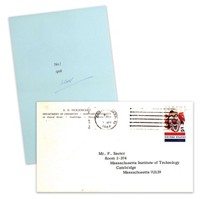Advertisement
Grab your lab coat. Let's get started
Welcome!
Welcome!
Create an account below to get 6 C&EN articles per month, receive newsletters and more - all free.
It seems this is your first time logging in online. Please enter the following information to continue.
As an ACS member you automatically get access to this site. All we need is few more details to create your reading experience.
Not you? Sign in with a different account.
Not you? Sign in with a different account.
ERROR 1
ERROR 1
ERROR 2
ERROR 2
ERROR 2
ERROR 2
ERROR 2
Password and Confirm password must match.
If you have an ACS member number, please enter it here so we can link this account to your membership. (optional)
ERROR 2
ACS values your privacy. By submitting your information, you are gaining access to C&EN and subscribing to our weekly newsletter. We use the information you provide to make your reading experience better, and we will never sell your data to third party members.
Education
Newscripts
Misspelling mail and chemistry postage
by Jyllian Kemsley
April 3, 2017
| A version of this story appeared in
Volume 95, Issue 14
Misspellings inspire mail
After the Newscripts gang kicked off 2017 with a treatise on word isomers—also known as misspellings—our readers weighed in: “An example I show my students in my chemical information sources course is the misspelling of fluorescence,” writes Philip Barnett of New York City. “A SciFinder search reveals a surprising number of articles containing the word ‘flouresence’ in their titles. Makes me wonder if these investigators completely understood the phenomena they are reporting.”
Barnett also points out a paper from 1981, “Oxonium Ions. Solvatin by Single Acetonitrile Molecules in the Gas Phase and by Bulk Solvents” (J. Am. Chem. Soc. 1981, DOI: 10.1021/ja00408a028). The title is corrected in the electronic record, but “solvatin” remains in the PDF version to delight those who click through.
Reader Mark Maxwell, of Egg Harbor City, N.J., notes that drug misspellings can be more than just embarrassing—they can influence legal outcomes. The State of New Jersey once had “alphazolam” listed as a controlled substance. A case involving the antianxiety drug alprazolam was consequently dismissed.
Transcripts of court hearings can also be a source of entertainment. Maxwell shares an excerpt: “And the morphine was reacted with aseedick anhideride to make heroine.”
Your humble Newscripts writer confesses to once having to correct a story that mentioned phosphorous instead of phosphorus. Alan Ehrlich, of Bethesda, Md., says that phosphorous could have been correct, depending on context. Merriam-Webster’s Collegiate Dictionary defines phosphorous as “of, relating to, or containing phosphorus especially with a valence lower than in phosphoric compounds.” For example, phosphonic acid, H3PO3, is also called phosphorous acid. The use in my story—and the near-appearance of “phosphorous” on a recent C&EN table of contents—would still have been incorrect.
Last but not least, it turned out that we had a typo in the first sentence of the original column about misspellings: “Several years ago, an international team of scientists developed the ‘Rat Grimace Scale’ as a way to reliability and accurately quantify pain in research studies of the rodents” (Jan. 9, page 40; now corrected). The next time we hire a copy editor, we’d like eagle-eyed Cindy Harbin, of Ypsilanti, Mich., to apply.
Chemistry philatelist shows off his collection
Now that we’re done collecting scientific misspellings, we’ll turn to postage stamps. In particular, stamps related to chemistry.
Maurice Snook, Newscripts reader and alternate councilor of the American Chemical Society’s Northeast Georgia Section, collected his first chemistry stamp as a teenager in the late 1950s. Already a stamp aficionado, he visited a post office on a trip to Canada and purchased the 25-cent stamp, which has a flask design celebrating Canada’s chemical industry.

But it was not until about 15 years ago that Snook started collecting chemistry-themed stamps in earnest, after reading the book “A Philatelic Ramble through Chemistry” by Edgar Heilbronner and Foil A. Miller, a collection of essays about chemists and moments in chemical history that have found their way onto postage stamps.
Snook now has a display titled “The History of Chemistry through Postage Stamps” in the lobby of the chemistry building at the University of Georgia. More than 250 stamps illustrate topics such as alchemy, individual elements, properties of matter, spectroscopy, and people such as Joseph Priestley and Marie Curie.
Some of the stamps, such as a three-cent one commemorating ACS’s 75th anniversary, can still be purchased in large quantities, Snook notes. Back when his local section still sent out print newsletters, he would obtain chemistry stamps to mail them.
Jillian Jylian Jyllian Kemsley wrote this week’s column. Please send comments and suggestions to newscripts@acs.org.






Join the conversation
Contact the reporter
Submit a Letter to the Editor for publication
Engage with us on Twitter